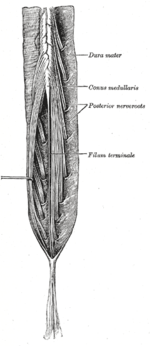| Cauda equina syndrome | |
|---|---|
 | |
| The cauda equina is the "horse tail" of nerves that branch off after the conus medullaris | |
| Specialty | Neurosurgery, orthopedics |
| Symptoms | Low back pain, pain that radiates down the leg, numbness around the anus, loss of bowel or bladder control[1] |
| Usual onset | Rapid or gradual[1] |
| Causes | Disc herniation, spinal stenosis, cancer, trauma, epidural abscess, epidural hematoma[1][2] |
| Diagnostic method | Medical imaging (MRI, CT scan)[1][3] |
| Treatment | Surgery (laminectomy)[1] |
| Prognosis | 20% risk of poor outcome |
| Frequency | 1 in 500,000 a year |
Cauda equina syndrome (CES) is a condition that occurs when the bundle of nerves below the end of the spinal cord known as the cauda equina is damaged.[2] Signs and symptoms include low back pain, pain that radiates down the leg, numbness around the anus, and loss of bowel or bladder control.[1] Onset may be rapid or gradual.[1]
The cause is usually a disc herniation in the lower region of the back.[1] Other causes include spinal stenosis, cancer, trauma, epidural abscess, and epidural hematoma.[1][2] The diagnosis is suspected based on symptoms and confirmed by medical imaging such as MRI or CT scan.[1][3]
CES is generally treated surgically via laminectomy.[1] Sudden onset is regarded as a medical emergency requiring prompt surgical decompression, with delay causing permanent loss of function.[4] Permanent bladder problems, sexual dysfunction or numbness may occur despite surgery.[1][3] A poor outcome occurs in about 20% of people despite treatment.[1] About 1 in 70,000 people is affected every year.[1] It was first described in 1934.[5]
- ^ a b c d e f g h i j k l m n Gardner A, Gardner E, Morley T (May 2011). "Cauda equina syndrome: a review of the current clinical and medico-legal position". European Spine Journal. 20 (5): 690–7. doi:10.1007/s00586-010-1668-3. PMC 3082683. PMID 21193933.
- ^ a b c "Cauda equina syndrome". Genetic and Rare Diseases Information Center (GARD). 2015. Retrieved 9 November 2017.
- ^ a b c "Cauda Equina Syndrome-OrthoInfo – AAOS". orthoinfo.aaos.org. March 2014. Retrieved 9 November 2017.
- ^ Cite error: The named reference
:1was invoked but never defined (see the help page). - ^ Chau AM, Xu LL, Pelzer NR, Gragnaniello C (2014). "Timing of surgical intervention in cauda equina syndrome: a systematic critical review". World Neurosurgery. 81 (3–4): 640–50. doi:10.1016/j.wneu.2013.11.007. PMID 24240024.